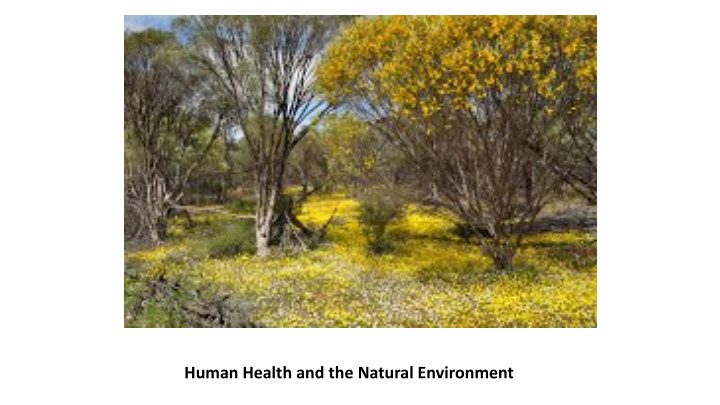



Human Health and the Natural Environment
Cover photo: Kimberley coastline, Western Australia, by Sheldon Pettit 2
Increasing salinity in Western Australia as a result of extensive clearing for agriculture
Our r relationship t to t the na natural env nvironment nt 6
Place A Attachment People do not simply look out over a landscape and say ‘this belongs to me’. They say, ‘I belong to this’. Concern for familiar topography, for the places one knows, is not about the loss of a commodity, but about the loss of identity . People belong in the world: it gives them a home (p. 109, original emphasis).Jacobs, 1995. • Attached community members - more satisfied with their lives, had stronger bonding and neighbourhood ties, trusted people more, and were generally less egocentric and more altruistic; more likely to resist change. • Evidence that “sense of place”, “place identity” – distinct dimension in neuronal processing. 7
Biophili lia • Biophilia - “the innately emotional affiliation of human beings to other living organisms.” (Wilson, 1984). • Implies that humans have a biological need for connection with nature and that this connection affects our personal well-being, productivity, and social relationships. • Gap between humans’ evolutionary environments & current living conditions. 8
Intervention: spending time in the natural environment
A Figure 1: Mean Post walk Scores on Digit Span Backwards for Park, Neighborhood, and Downtown Conditions; Taylor & Kuo (2008) A walk in the park is superior to drugs for children with ADHD 10
Where to put your best foot forward: Psycho-physiological responses to walking in natural and urban environments http://dx.doi.org/10.1016/j.jenvp.2015.11.003
Mean change in cognitive function (backwards digit span task) from baseline to 60-min post exposure follow-up by environment. http://dx.doi.org/10.1016/j.jenvp.2015.11.003
Cox et al (2017) found that in five different types of neighbourhood the amount of vegetation cover and afternoon bird abundance were positively associated with Photo credit Tony Kirkby a lower prevalence of depression, anxiety, and stress. DOI: http://dx.doi.org/10.1093/biosci/biw173 13
Physio iologic ical l effects o of contact w with n nature Lower stress indicators : salivary cortisol, blood pressure, heart rate, skin conductance, muscle tension (forest vs urban walk). Japanese studies of “ forest bathing” – decreased blood glucose levels in diabetic patients; more than exercise alone.
WHO R Repo port rts o on Urba ban G n Green n Spaces and nd Health h “The results indicate that urban green space is a necessary component for delivering healthy, sustainable and liveable cities. Interventions to increase or improve urban green space can deliver positive health, social and environmental outcomes for all population groups, particularly among lower socioeconomic status groups. There are very few, if any, other public health interventions that can achieve all of this, and especially the impact on active lifestyles, mental well-being and social interaction is frequently highlighted as a key benefit” (P 5).
Health Effects Exposure to and use of green spaces (after controlling for other variables): • Reductions in reported health problems (e.g. heart disease, cancer, musculoskeletal problems); • Reduced levels obesity, higher rates physical activity (note – greater benefits from ‘green’ exercise); • Higher self-rated mental health; lower rates depression; • Moderating the effects of climate, pollution; benefits for health. • Reductions in rates pre-term birth, low birth weight; • Enhanced cognitive development.
Gardening: improves mood, self-esteem, physiological indices; for patients with dementia reduces agitation, aggression and other symptoms.
Measuring quantity of common space vegetation Common space with a low Common space with a high level level of vegetation of vegetation
Buildings with more vegetation had fewer crimes overall 8 7 6 5 # of crimes overall 4 3 2 1 0 Low Medium High Quantity of vegetation
A study of 768 children in urban and rural communities found first-grade children are less likely to be obese if their parents perceive their neighborhoods to be safe. 17% of children were obese 4% of children were obese Lumeng JC, Appugliese D, Cabral HJ, Bradley RH, Zuckerman B. Neighborhood safety and overweight status in children. Archives of Pediatric and Adolescent Medicine 2006; 160(1):25-31.
Improved social relationships 21
Cont ntact with t the he na natural e l environment: • faster recovery from surgery; • lower crime rates; • improved social relationships; • improved relaxation; • reduced behaviour problems in children; better cognitive performance (attention restoration); • • reductions in reported health problems (e.g. heart disease, cancer, musculoskeletal problems); • reduced levels obesity; higher rates physical activity; improved immune functioning; • • higher self-rated mental health; • reduction of the ill effects of pollution, including noise pollution; • reduction urban heat island effect: • higher productivity; optimized exposure to sunlight and improved sleep. • 22
Conversely, environmental degradation produces ill effects 23
Recommend
More recommend